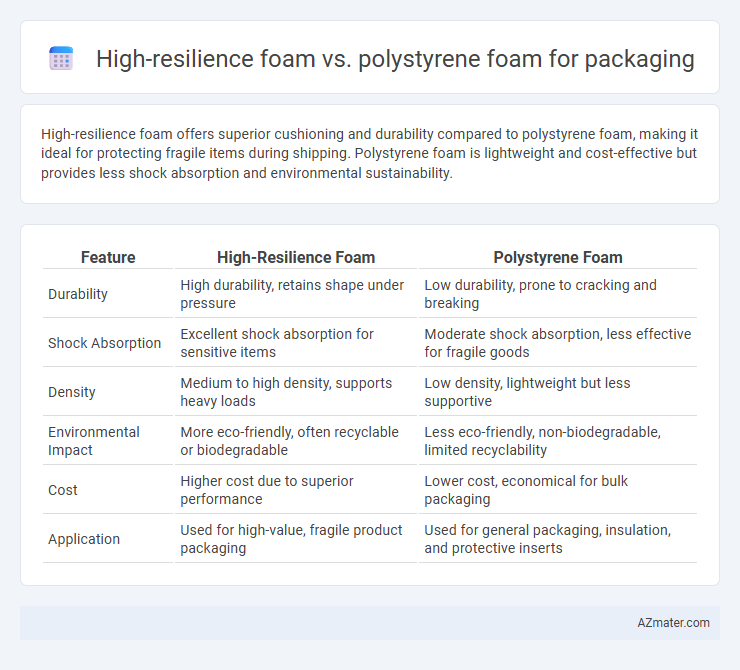High-resilience foam offers superior cushioning and durability compared to polystyrene foam, making it ideal for protecting fragile items during shipping. Polystyrene foam is lightweight and cost-effective but provides less shock absorption and environmental sustainability.
Table of Comparison
| Feature | High-Resilience Foam | Polystyrene Foam |
|---|---|---|
| Durability | High durability, retains shape under pressure | Low durability, prone to cracking and breaking |
| Shock Absorption | Excellent shock absorption for sensitive items | Moderate shock absorption, less effective for fragile goods |
| Density | Medium to high density, supports heavy loads | Low density, lightweight but less supportive |
| Environmental Impact | More eco-friendly, often recyclable or biodegradable | Less eco-friendly, non-biodegradable, limited recyclability |
| Cost | Higher cost due to superior performance | Lower cost, economical for bulk packaging |
| Application | Used for high-value, fragile product packaging | Used for general packaging, insulation, and protective inserts |
Introduction to Modern Packaging Materials
High-resilience foam offers superior cushioning and impact absorption compared to polystyrene foam, making it a preferred choice for protecting fragile goods during transit. Polystyrene foam, known for its lightweight and affordability, remains popular in packaging but lacks the elasticity and durability found in high-resilience foam materials. Modern packaging increasingly favors high-resilience foam for sustainable, shock-resistant solutions in electronics, medical devices, and delicate consumer products.
What is High-Resilience Foam?
High-resilience foam is a type of polyurethane foam characterized by its superior elasticity, durability, and ability to quickly regain its original shape after compression, making it ideal for protective packaging applications where cushioning and impact resistance are critical. Unlike polystyrene foam, which is rigid and prone to cracking, high-resilience foam provides better shock absorption and long-term resilience, reducing damage risks during transport. This foam's open-cell structure allows for enhanced breathability and flexibility, key factors in safeguarding fragile or sensitive items effectively.
Understanding Polystyrene Foam
Polystyrene foam, widely used in packaging, offers excellent rigidity and lightweight properties, making it ideal for protecting fragile items during shipping. Its closed-cell structure provides superior insulation and resistance to moisture compared to high-resilience foam, which is more flexible and shock-absorbent but less sturdy. Understanding the thermal insulation and cushioning characteristics of polystyrene foam helps optimize packaging solutions for electronics and food products requiring both durability and thermal stability.
Key Differences in Material Properties
High-resilience (HR) foam offers superior elasticity and durability compared to polystyrene foam, providing enhanced shock absorption and long-term performance in packaging applications. Polystyrene foam, characterized by its rigid, lightweight structure, excels in moisture resistance and thermal insulation but lacks the flexibility and energy recovery of HR foam. The key material differences impact the choice of foam based on packaging needs, where HR foam suits cushioning fragile, irregular items, while polystyrene is preferred for protective inserts requiring structural support.
Cushioning Performance Comparison
High-resilience foam offers superior cushioning performance compared to polystyrene foam due to its excellent energy absorption and rebound properties, which protect delicate items from impacts and vibrations more effectively. Polystyrene foam, while lightweight and cost-effective, provides less shock absorption and tends to compress permanently under repeated stress, reducing its protective capabilities. High-resilience foam's durability and resilience make it ideal for packaging fragile or high-value products requiring enhanced protection during transit.
Durability and Longevity in Transit
High-resilience foam offers superior durability and longevity in transit due to its ability to withstand repeated compression and maintain its shape, providing consistent protection over extended periods. Polystyrene foam, while lightweight and cost-effective, is more prone to cracking and deformation under continuous pressure, reducing its effectiveness in long-haul shipping. The enhanced resilience of high-resilience foam minimizes product damage and packaging waste, making it a preferred choice for fragile and high-value goods.
Environmental Impact and Sustainability
High-resilience foam offers superior durability and longer lifecycle, reducing waste generation compared to polystyrene foam, which is often single-use and difficult to recycle. Polystyrene foam poses significant environmental challenges due to its non-biodegradability and persistent pollution in ecosystems, while high-resilience foam can be engineered from more eco-friendly materials that enhance compostability and recyclability. Sustainable packaging decisions increasingly favor high-resilience foam for its potential to decrease landfill burden and carbon footprint relative to traditional polystyrene options.
Cost Analysis: High-Resilience Foam vs Polystyrene Foam
High-resilience foam typically costs more upfront than polystyrene foam due to its superior durability and cushioning properties, making it a cost-effective option for protecting fragile or high-value items during shipping. Polystyrene foam offers a lower initial price but may incur higher long-term costs due to its lower impact resistance and potential for breakage or product damage. When evaluating packaging expenses, businesses must consider both material costs and the potential savings from reduced product damage and returns associated with high-resilience foam.
Industry Applications and Suitability
High-resilience foam offers superior cushioning and durability, making it ideal for protecting delicate electronics and automotive components during shipping. Polystyrene foam, known for its lightweight and cost-effectiveness, excels in packaging fragile consumer goods and food containers where insulation and shock absorption are essential. Industries focused on long-term storage and repeated handling often prefer high-resilience foam, while polystyrene foam suits mass production and single-use packaging needs.
Which Foam is Best for Packaging Needs?
High-resilience foam offers superior cushioning and durability, making it ideal for protecting fragile or high-value items during shipping and handling. Polystyrene foam, known for its lightweight and cost-effectiveness, provides adequate insulation and shock absorption but lacks the flexibility and long-term resilience of high-resilience foam. For packaging needs that prioritize product protection and repeated impact resistance, high-resilience foam is generally the best choice.

Infographic: High-resilience foam vs Polystyrene foam for Packaging
 azmater.com
azmater.com